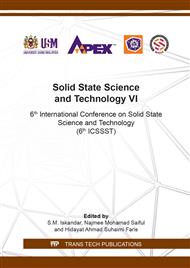[1]
Najafabadi, A.T., Emerging applications of graphene and its derivatives in carbon capture and conversion: Current status and future prospects. Renewable and Sustainable Energy Reviews, 2015. 41: pp.1515-1545.
DOI: 10.1016/j.rser.2014.09.022
Google Scholar
[2]
Chen, X., L. Zhang, and S. Chen, Large area CVD growth of graphene. Synthetic Metals, 2015. 210: pp.95-108.
DOI: 10.1016/j.synthmet.2015.07.005
Google Scholar
[3]
Sarajlic, O.I. and R.G. Mani, Mesoscale scanning electron and tunneling microscopy study of the surface morphology of thermally annealed copper foils for graphene growth. Chemistry of Materials, 2013. 25(9): pp.1643-1648.
DOI: 10.1021/cm400032h
Google Scholar
[4]
Gan, L. and Z. Luo, Turning off hydrogen to realize seeded growth of subcentimeter single-crystal graphene grains on copper. Acs Nano, 2013. 7(10): pp.9480-9488.
DOI: 10.1021/nn404393b
Google Scholar
[5]
Shin, Y.C. and J. Kong, Hydrogen-excluded graphene synthesis via atmospheric pressure chemical vapor deposition. Carbon, 2013. 59: pp.439-447.
DOI: 10.1016/j.carbon.2013.03.037
Google Scholar
[6]
Jung, D.H., C. Kang, M. Kim, H. Cheong, H. Lee, and J.S. Lee, Effects of hydrogen partial pressure in the annealing process on graphene growth. The Journal of Physical Chemistry C, 2014. 118(7): pp.3574-3580.
DOI: 10.1021/jp410961m
Google Scholar
[7]
Gui, Y., H. Sun, H. Yan, H. Wang, Y. Zhang, X.M. Song, and R. Jia, Effects of substrates on Raman spectroscopy in chemical vapor deposition grown graphene transferred with poly (methyl methacrylate). Solid State Communications, 2017. 264: pp.31-34.
DOI: 10.1016/j.ssc.2017.04.010
Google Scholar
[8]
Iqbal, M., A.K. Singh, M. Iqbal, and J. Eom, Raman fingerprint of doping due to metal adsorbates on graphene. Journal of Physics: Condensed Matter, 2012. 24(33): p.335301.
DOI: 10.1088/0953-8984/24/33/335301
Google Scholar
[9]
Guo, B., Q. Liu, E. Chen, H. Zhu, L. Fang, and J.R. Gong, Controllable N-doping of graphene. Nano letters, 2010. 10(12): pp.4975-4980.
DOI: 10.1021/nl103079j
Google Scholar
[10]
Koo, E. and S.-Y. Ju, Role of residual polymer on chemical vapor grown graphene by Raman spectroscopy. Carbon, 2015. 86: pp.318-324.
DOI: 10.1016/j.carbon.2015.01.055
Google Scholar
[11]
Mallet-Ladeira, P., P. Puech, C. Toulouse, M. Cazayous, N. Ratel-Ramond, P. Weisbecker, G.L. Vignoles, and M. Monthioux, A Raman study to obtain crystallite size of carbon materials: a better alternative to the Tuinstra–Koenig law. Carbon, 2014. 80: pp.629-639.
DOI: 10.1016/j.carbon.2014.09.006
Google Scholar
[12]
Li, W., G. Cheng, Y. Liang, B. Tian, X. Liang, L. Peng, A.H. Walker, D.J. Gundlach, and N.V. Nguyen, Broadband optical properties of graphene by spectroscopic ellipsometry. Carbon, 2016. 99: pp.348-353.
DOI: 10.1016/j.carbon.2015.12.007
Google Scholar
[13]
Li, X., Y. Zhu, W. Cai, M. Borysiak, B. Han, D. Chen, R.D. Piner, L. Colombo, and R.S. Ruoff, Transfer of large-area graphene films for high-performance transparent conductive electrodes. Nano letters, 2009. 9(12): pp.4359-4363.
DOI: 10.1021/nl902623y
Google Scholar


